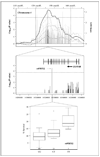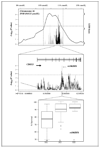Mapping genes that contribute to daunorubicin-induced cytotoxicity
- PMID: 17545624
- PMCID: PMC2735868
- DOI: 10.1158/0008-5472.CAN-06-4431
Mapping genes that contribute to daunorubicin-induced cytotoxicity
Abstract
Daunorubicin is an anthracycline antibiotic agent used in the treatment of hematopoietic malignancies. Toxicities associated with this agent include myelosuppression and cardiotoxicity; however, the genes or genetic determinants that contribute to these toxicities are unknown. We present an unbiased genome-wide approach that incorporates heritability, whole-genome linkage analysis, and linkage-directed association to uncover genetic variants contributing to the sensitivity to daunorubicin-induced cytotoxicity. Cell growth inhibition in 324 Centre d' Etude du Polymorphisme Humain lymphoblastoid cell lines (24 pedigrees) was evaluated following treatment with daunorubicin for 72 h. Heritability analysis showed a significant genetic component contributing to the cytotoxic phenotypes (h2 = 0.18-0.63 at 0.0125, 0.025, 0.05, 0.1, 0.2, and 1.0 mumol/L daunorubicin and at the IC50, the dose required to inhibit 50% cell growth). Whole-genome linkage scans at all drug concentrations and IC50 uncovered 11 regions with moderate peak LOD scores (> 1.5), including 4q28.2 to 4q32.3 with a maximum LOD score of 3.18. The quantitative transmission disequilibrium tests were done using 31,312 high-frequency single-nucleotide polymorphisms (SNP) located in the 1 LOD confidence interval of these 11 regions. Thirty genes were identified as significantly associated with daunorubicin-induced cytotoxicity (P < or = 2.0 x 10(-4), false discovery rate < or = 0.1). Pathway and functional gene ontology analysis showed that these genes were overrepresented in the phosphatidylinositol signaling system, axon guidance pathway, and GPI-anchored proteins family. Our findings suggest that a proportion of susceptibility to daunorubicin-induced cytotoxicity may be controlled by genetic determinants and that analysis using linkage-directed association studies with dense SNP markers can be used to identify the genetic variants contributing to cytotoxicity.
Figures



References
-
- Davis HL, Davis TE. Daunorubicin and Adriamycin in cancer treatment: an analysis of their roles and limitations. Cancer treatment reports. 1979;63:809–815. - PubMed
-
- Chaires JB, Fox KR, Herrera JE, Britt M, Waring MJ. Site and sequence specificity of the daunomycin-DNA interaction. Biochemistry. 1987;26:8227–8236. - PubMed
-
- Bachur NR, Yu F, Johnson R, Hickey R, Wu Y, Malkas L. Helicase inhibition by anthracycline anticancer agents. Mol Pharmacol. 1992;41:993–998. - PubMed
-
- Palayoor ST, Stein JM, Hait WN. Inhibition of protein kinase C by antineoplastic agents: implications for drug resistance. Biochem Biophys Res Commun. 1987;148:718–725. - PubMed
-
- Ohmori T, Podack ER, Nishio K, et al. Apoptosis of lung cancer cells caused by some anti-cancer agents (MMC, CPT-11, ADM) is inhibited by bcl-2. Biochem Biophys Res Commun. 1993;192:30–36. - PubMed
Publication types
MeSH terms
Substances
Grants and funding
LinkOut - more resources
Full Text Sources
Other Literature Sources
Research Materials

